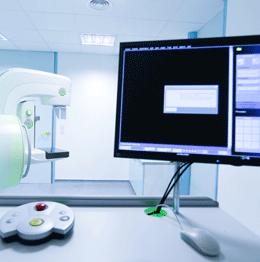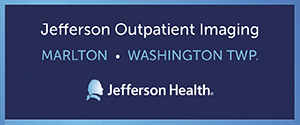
The latest advances in breast cancer detection and care.
Jacqueline Timmons knew something was up when she saw her family doctor about some changes in her breasts and was told she needed a mammogram that same day. The faster things moved, the more she began to realize none of this was routine. After completing the mammogram test, Simmons was told right away that she needed to schedule a biopsy. And on Oct. 31 of last year, Timmons was diagnosed with Stage 3 ductal cancer. She was told she would need to have a port put in the next day to begin receiving chemotherapy
“I think that’s when it got real,” says Timmons, who lives on McGuire Air Force Base with her family. “There had been a lot of scheduling and a lot of information thrown at us and I think my husband and I both felt numb. But getting that port put in made it all very real.” From there, Timmons began a journey that so many women fear. But like so many others, she has come out on the other side to tell her story.
Fortunately for many women, due to the latest screening techniques and ongoing advances in breast cancer treatment, the survival rate for the disease continues to climb. But being diligent about your own health care remains a critical factor.
Screening matters
Part of that is knowing your family history, says Dr. Kathleen V. Greatrex, chief of radiology and nuclear medicine at Our Lady of Lourdes Medical Center. “If you’ve had a mother or a sister who had breast cancer, it’s important you know at what age,” Dr. Greatrex says. “We typically begin screening for breast cancer in first blood relatives 10 years prior to the age your relative was diagnosed. In other words, if your mother had breast cancer at age 40, we would begin screening you at age 30.”
One of the great advances in breast cancer detection has been in the genetic testing arena. Doctors now know a woman’s risk of breast cancer or ovarian cancer is greatly increased if she inherits a harmful mutation of the BRCA1 gene or BRCA2 gene. “If an individual is found to have this mutation, we add additional screening,” says Dr. Greatrex. “At Lourdes, they would receive a mammogram every six months and an MRI every six months—two screenings each year.”
It’s also important that patients are aware of their breast density. Breasts are composed of both fatty and glandular tissue and when there’s a lot of glandular tissue, breasts are considered “dense” which can make it harder to detect cancer. It recently became a law in the state of New Jersey that women who have dense breasts are notified following their mammogram.
“When a woman has very dense breasts, it’s a ‘polar bear in a snowstorm’ situation,” says Dr. Catherine Piccoli, director of women’s imaging at South Jersey Radiology Associates. “Dense breasts can lead to more false positives and it can make cancer more difficult to detect. In some cases we may utilize additional forms of screening such as ultrasound or MRI to complement the mammography.” But the most current advance in screening techniques has been the introduction of digital tomosynthesis, technology which can create a 3-D picture using X-rays. Because this technology is a bit more sensitive, it may also be a good fit for those with dense breast tissue.
“Research has shown that with ‘tomo’ we’re finding more cancers and we’re finding it sooner than we did with 2D mammography,” Dr. Piccoli says. “We have also found it very helpful in work-ups. If an abnormality is found on a 2D screening, we can use the 3D technology to help identify the problem.”
Treatment and care
In addition to advances in screening technologies that are helping doctors identify breast cancer earlier, there has also been significant advancement in treatment. Dr. Priya Gor, a medical oncologist specializing in breast cancer at Regional Cancer Care Associates, says that drugs have significantly improved over the years. Today, we even have drugs that can help prevent the development of breast cancer for women at high risk.
“Care has become much more specialized,” Dr. Gor says. “One of the biggest advances today is biologically targeted therapies. As we’ve learned more about the biology of these different cancers, we’ve learned that there is not a one-size-fits-all approach. And we are already tailoring our treatments around the biological features of the cancer.”
It’s also been exciting that new drugs are being developed to avoid resistance to existing therapies, she notes. “Right now, they’re being used and studied in a metastatic setting where the cancer has already spread. But the ones that have shown promise are already being brought into the curative setting in the form of clinical trials.”
Other examples of targeted therapies being developed include a class of drugs called PARP inhibitors which are showing promise among those that carry the BRCA mutation, says Dr. Gor. “We’re able to target and tailor treatment better than ever before and advances continue to happen,” she adds.
Advances in surgery
Surgical advances have also come a long way. Currently, the DIEP flap is the most advanced form of breast reconstruction available today and is being performed at Virtua. With the DIEP flap procedure, skin and tissue are taken from the abdomen in order to recreate the breast. This is different than the old TRAM procedure where abdominal muscle was also taken.
“With DIEP flap, we avoid sacrificing the muscle, making the recovery time in comparison to the TRAM flap procedure much shorter,” says Dr. Sameer A. Patel, a surgeon with the Virtua Fox Chase Cancer program. “If you have the choice of saving that muscle, it’s obviously a big benefit.”
While certainly nobody wants to be faced with a breast cancer diagnosis, the “tummy tuck” that comes along with this procedure is a silver lining, says Timmons, who had this procedure done under the care of Dr. Patel. “Implants were an option but I liked the idea of not having anything foreign in my body,” she says. “It’s my own body tissue. And that tummy tuck was a nice little positive after a whole bunch of negatives. After having two kids I had spent years trying to get back that flat stomach and now I did, plus I never had to lose my breasts.”
While the recovery is a little longer than that of implants, everything is done in one procedure. For Timmons, it was a 10-hour surgery where her tumor, lymph nodes, and breasts were removed, followed by the reconstruction. “With this procedure we do everything at once so the recovery is a little more involved but you avoid a second operation, and a second time under anesthesia, which is always a benefit,” Dr. Patel says.
A long journey
Though it was a trying time for Timmons and she says she is still “journeying” to the other side as she continues to heal from the intense rounds of radiation she endured, she says she is finally feeling “more normal” again. She attributes much of that to the DIEP flap procedure.
“I burst into tears when I looked down and saw breasts,” Timmons says. “You lose so much of what makes you feel like a woman—your hair, your eyelashes, and your taste buds. But to wake up from surgery and still have my breasts was a gift. It helped me feel more normal. You’re definitely changed after going through something like this but those things that make you still feel ‘normal’ help you adapt to that change. I look in the mirror and I feel like I look natural. I feel good about myself and that’s a good feeling to have after going through all this.”
Preserving Hope
While breast cancer is a devastating diagnosis, the latest advances have made it increasingly curable and as a result many women go on to live long lives following treatment. There are currently more than 2.8 million women living with breast cancer in the United States. Although certain cancer treatments like chemotherapy and radiation can be very effective in treating cancer, they can also have profound effects on fertility which is why fertility preservation may be a consideration.
“Women are born with all the eggs they will ever have,” says Dr. Oumar Kuzbari, reproductive endocrinologist and fertility specialist at South Jersey Fertility.
“Chemotherapy can damage and destroy the eggs causing a decrease in ovarian reserve [the total number of eggs in both ovaries]. As a result, some women may face infertility or early menopause.”
Dr. Kuzbari suggests that young cancer patients schedule a consultation with a fertility specialist to discuss their options. There are several strategies to preserve fertility including embryo banking (freezing), egg freezing, and donor eggs. All of these options should be discussed with a specialist as soon as possible so that there is no need to delay cancer therapy.
Dr. Kuzbari adds: “Ideally it is essential to preserve fertility before any treatment begins because most fertility preservation procedures work best if initiated prior to starting cancer therapy.”
Published (and copyrighted) in South Jersey Magazine, Volume 11, Issue 7 (October, 2014).
For more info on South Jersey Magazine, click here.
To subscribe to South Jersey Magazine, click here.
To advertise in South Jersey Magazine, click here.












